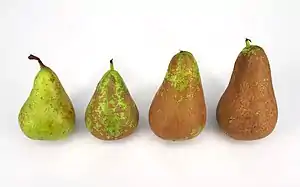Russeting
Russeting or russetting is an abnormality of fruit skin which manifests in russet-colored (brownish) patches that are rougher than healthy skin. It is a common feature in apples and pears. Russeting is typically an undesirable trait, which reduces the storage life of fruits and makes their appearance unattractive to consumers,[1] although some cultivars, so-called russet apples, are appreciated for the feature.

Causes
In apples and pears, russet results from micro-cracking of the cuticle, the outer epidermal layer of the fruit. The cuticle is a natural waterproof barrier composed of a polymerized cutin matrix embedded with waxes, which protects the fruit from outside stresses, and helps maintain post-harvest preservation. When the cuticle cracks, a corky suberized layer is formed on the fruit skin.[1][2]
Apples are particularly susceptible to russet. Many naturally-occurring varieties exhibit the feature consistently, while other cultivars may develop russet due to environmental stresses. As a result, cuticular structure is impaired, leading to reduced strength of the peel, which impacts handling and post-harvest processing. Russeting and cuticular cracks may accelerate the development of flesh browning due to oxidation, as well as softening of internal tissue due to the loss of an external support.[1]
Gallery
 An Egremont Russet apple, almost completely covered in russeting
An Egremont Russet apple, almost completely covered in russeting Conference pear
Conference pear
See also
References
- Lashbrooke, J.; Aharoni, A.; Costa, F. (2015). "Genome investigation suggests MdSHN3, an APETALA2-domain transcription factor gene, to be a positive regulator of apple fruit cuticle formation and an inhibitor of russet development". Journal of Experimental Botany. 66 (21): 6579–89. doi:10.1093/jxb/erv366. PMC 4623677. PMID 26220084.
- Opara, Linus U.; Studman, Clifford J.; Banks, Nigel H. (2010). "Fruit Skin Splitting and Cracking". In Jules, Janick (ed.). Horticultural Reviews. 55. John Wiley & Sons. pp. 225–. ISBN 978-0-470-65061-5.